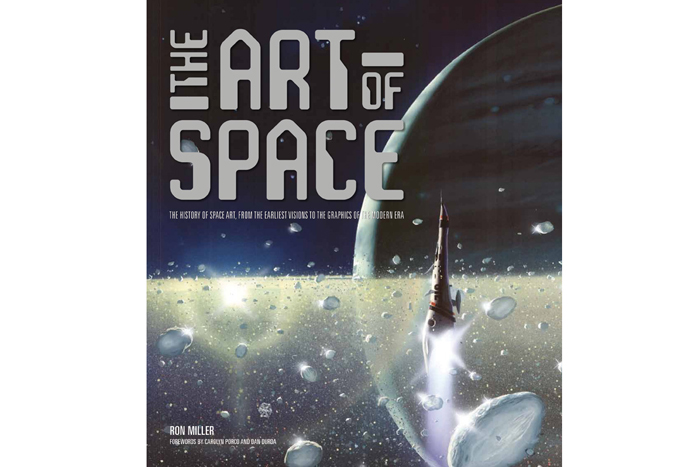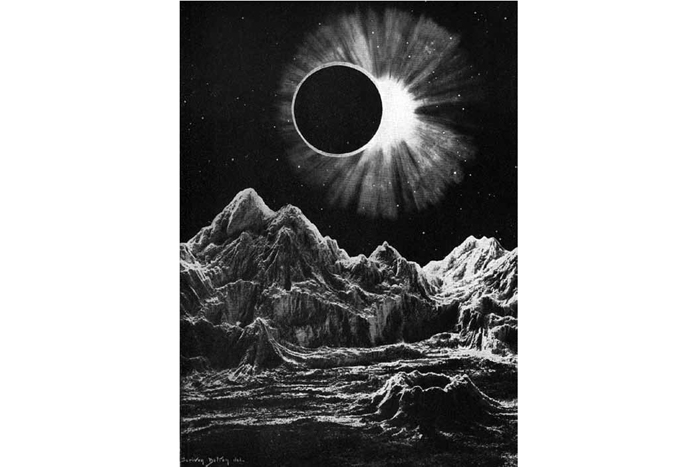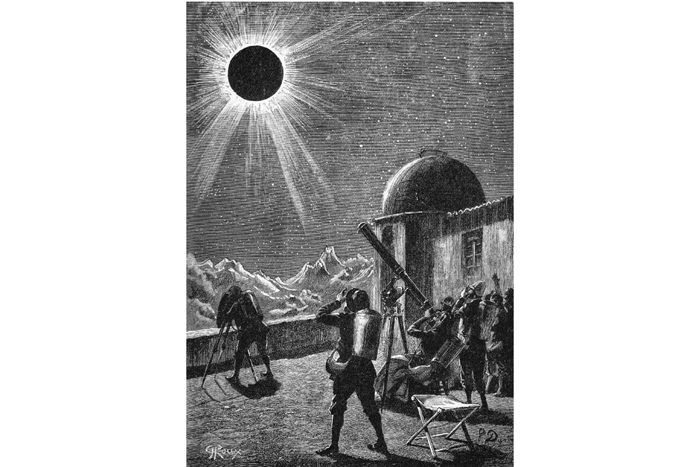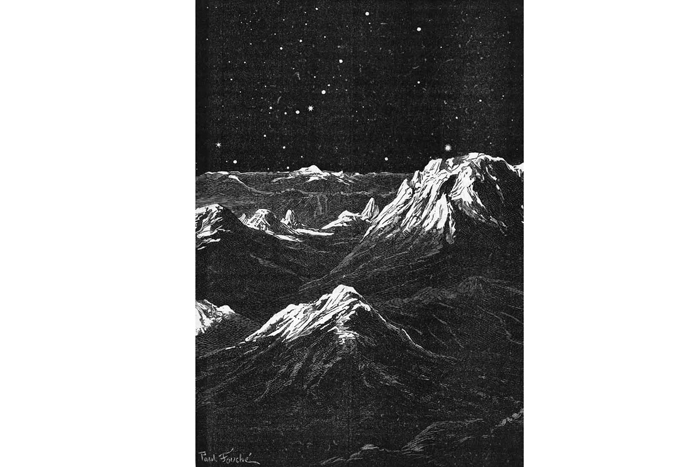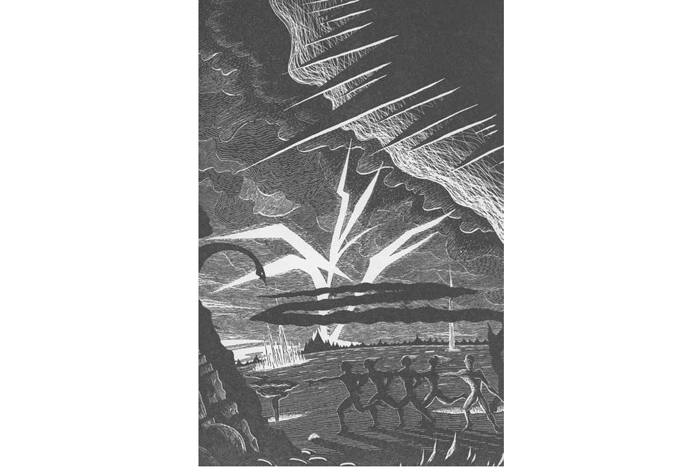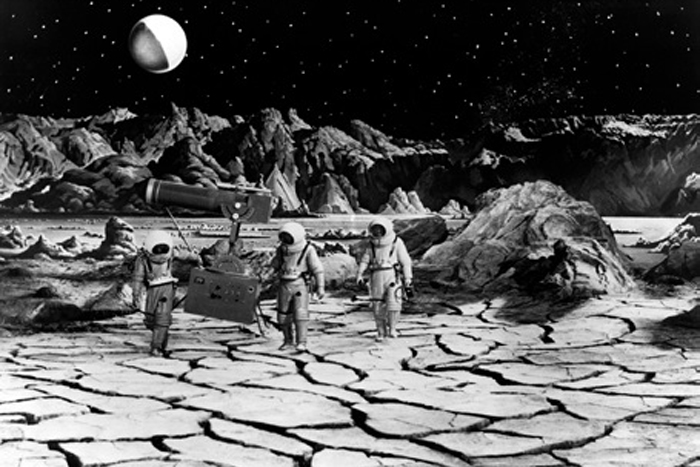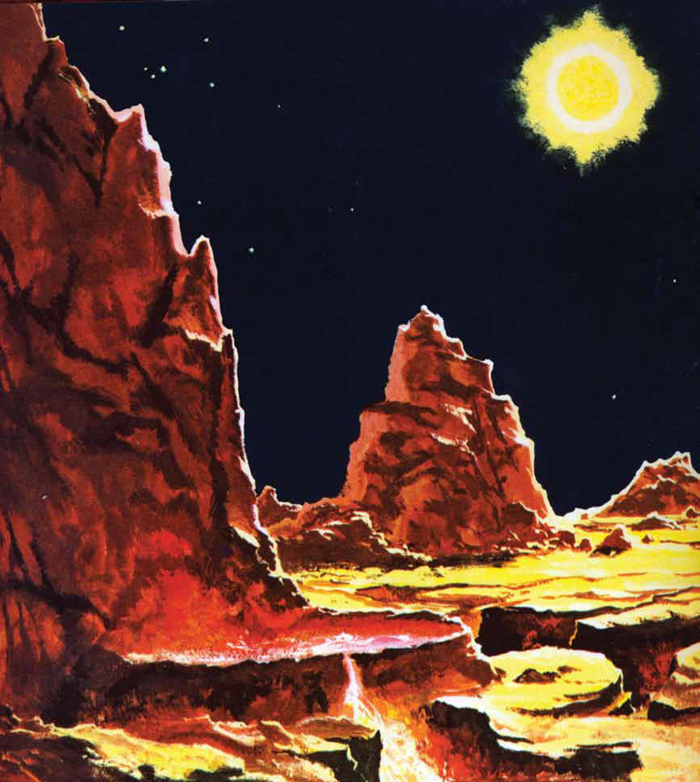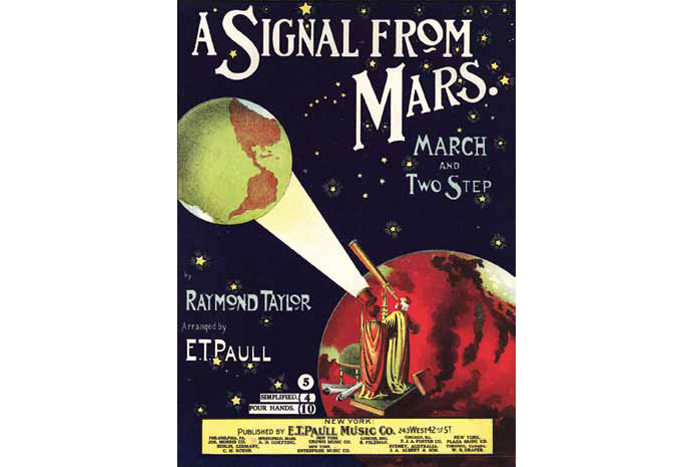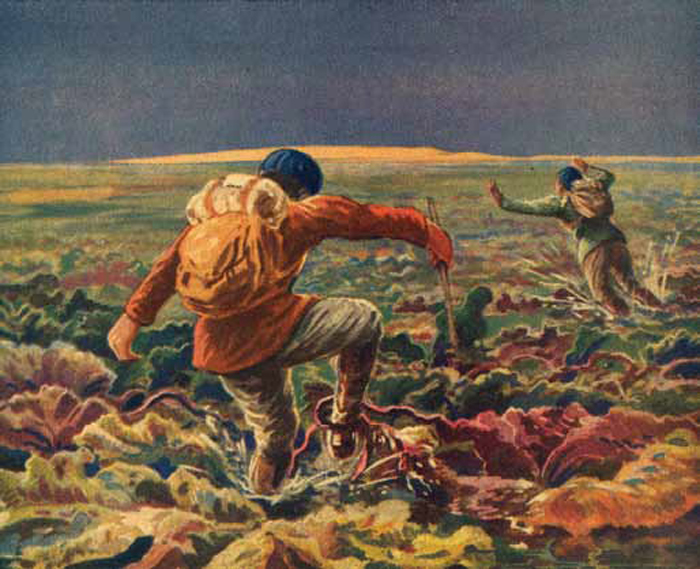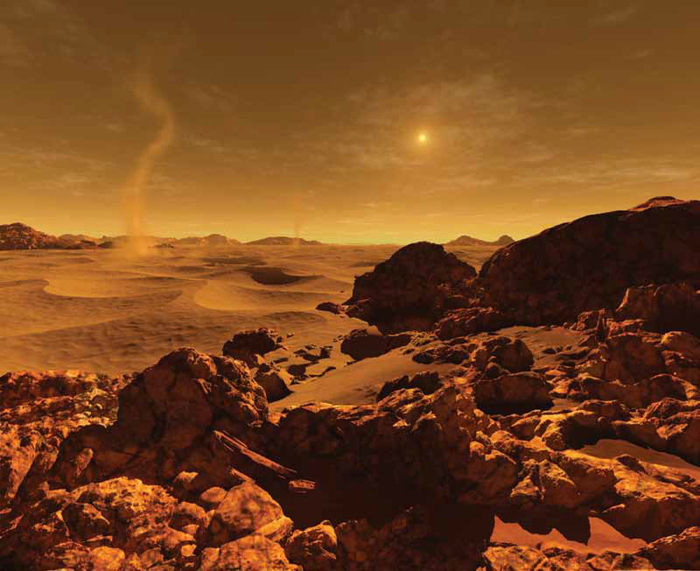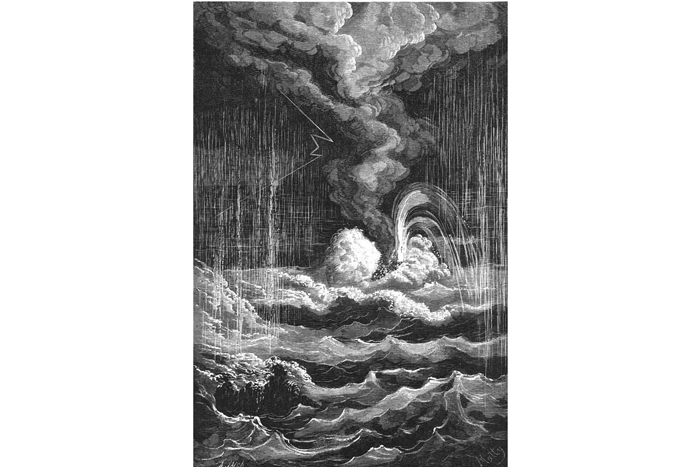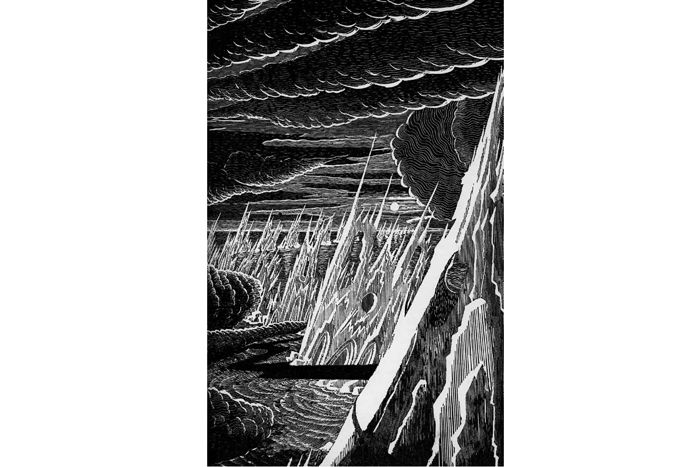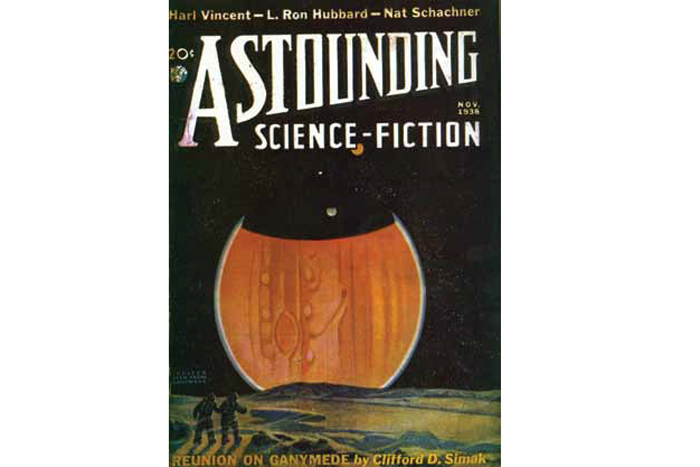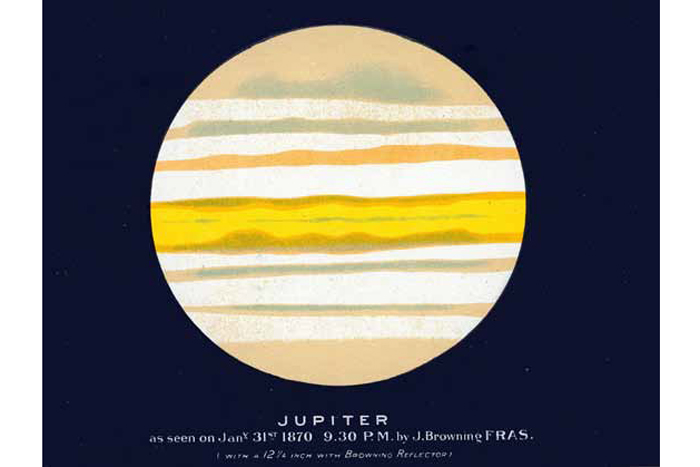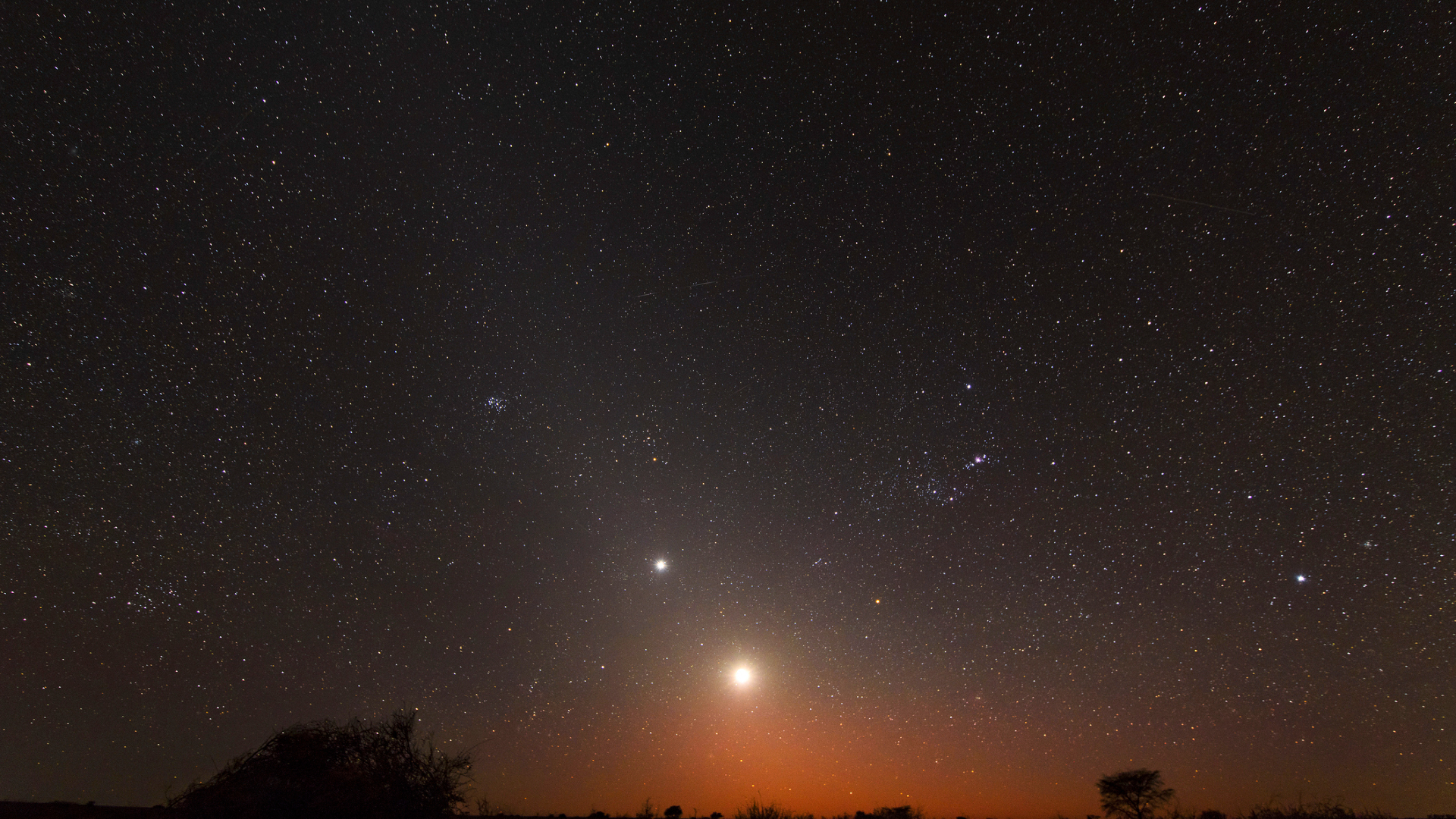'The Art of Space' (US 2014): Book Excerpt

Ron Miller contributed this excerpt to Space.com's Expert Voices: Op-Ed & Insights.
In "The Art of Space: The History of Space Art, from the Earliest Visions to the Graphics of the Modern Era," artist and author Ron Miller explores the history and evolution of artwork that envisions the landscapes, life forms and technologies that could lie beyond the Earth.
Using more than 350 images, Miller captures centuries of space art and the science that drove it, and how that art has inspired not only imaginations, but off-world exploration.
Below is the first chapter from Miller's book.
Planets and Moons: Surveying our Solar System
Before the publication of Jules Verne's From the Earth to the Moon (1865) and Around the Moon (1869), literary journeys to the moon and planets were almost exclusively limited to allegory, fantasy or satire. Two things were needed to change fantasy into reality.
First, there needed to be solid, scientific knowledge about the actual conditions that existed beyond the earth's atmosphere and on the moon and other planets. Second, there needed to be a realistic means of leaving the earth.
Breaking space news, the latest updates on rocket launches, skywatching events and more!
Before the seventeenth century, little was known of the moon. It was certainly not thought of as a world in its own right. The stars, while some were brighter than others, were nevertheless thought to be at more or less the same distance from the earth — though just what that distance might be was a matter for debate. The planets were merely a special class of bright stars that wandered among the other "fixed" stars. Indeed, the word "planet" comes from the Greek word planete, meaning "wanderer." While today we use the word to mean any solid, spherical body circling a star, 500 years ago it meant one of the five bright stars that were not "fixed" in the heavens. The term "Planet Earth," so familiar to us today, would have been nonsensical.
New worlds
It was unthinkable to the ancients that those twinkling lights might be actual places that could be traveled to, and only the moon served as a destination in a rare handful of fantasies. Even then it was not regarded as something altogether physical, but rather a kind of ethereal never-never land. But in the year 1610, and almost literally overnight, Galileo Galilei (1564–1642) forever changed mankind's view of the universe. Turning a telescope to the night sky for the first time, the moon, he reported, "does not possess a smooth and polished surface, but one rough and uneven, and just like the face of the earth itself, is everywhere full of vast protuberances, deep chasms, and sinuosities." While many of the early Greek philosophers had speculated that the moon might be like this, Galileo was the first to know: he had seen it with his own eyes. Turning his telescope on the rest of the planets. Galileo discovered that they did not have the same appearance in his telescope as other stars. No matter what the magnification used, stars retained the appearance of points of light. But the planets were revealed as tiny disks with indistinct features. Jupiter, Galileo discovered, was a pale, golden globe with — astonishingly — four tiny worldlets circling it. Venus, he found, showed phases exactly like the moon. They were obviously other worlds like the moon and the earth. The Catholic Church forced Galileo to recant his discoveries and related interpretations of them, but the damage had already been done. When human beings looked skyward they no longer saw abstract points of light. They saw the infinite possibilities of new worlds.
Space travel
The German astronomer Johannes Kepler (1571–1630) wrote his strange moon-voyage tale, Somnium, around the time that Galileo's discoveries first became known. It was the first science-fiction novel written by a scientist — or, for that matter, by anyone at all knowledgeable in science. And, important to us, it is perhaps the first example of an astronomical discovery influencing an art form. It is unfortunate that the novel was not illustrated, for if it had been, it might have provided the first true astronomical art.
As Galileo was discovering new worlds in the sky, so new worlds were being discovered here on earth. Scarcely more than a century earlier the continents of North and South America had been discovered quite by accident, lying unsuspected and unknown on the far side of the Atlantic Ocean. Soon, hundreds of ships and thousands of explorers, colonists, soldiers, priests, and adventurers had made the journey to these fertile, rich, and strange new lands. Now they learned that an Italian scientist had found that not only did our own earth harbor unsuspected worlds, but that the sky was full of them, too.
How frustrating it must have been! The new worlds of the Americas, which lay invisibly beyond the horizon and which existed for the vast majority of Europeans only in the form of traveler's tales and evocative if imaginative charts, nevertheless could be visited by anyone possessing the funds or courage. But now here were whole new earths — Venus, Mars, Jupiter, Saturn, and the moon — which could be seen by anyone and even mapped; whole new planets with unimaginable continents and riches… yet there was no way to touch them! They were like a mirage of an oasis in the middle of the desert, in plain sight yet tantalizingly out of reach.
Little wonder, then, that Galileo's discoveries could not be easily suppressed. They were followed by an unprecedented spate of space travel stories: Somnium (published in 1634), The Man in the Moone (1638), A Voyage to the Moon (1657), A Voyage to the World of Cartesius (1694), Iter Lunare (1703), John Daniel (1752), Voltaire's "Micromegas" (1752), and countless others. If it was not possible to reach these new worlds in the sky in reality, it would be done on the page.
Few of these books were illustrated, and, when they were, the artists demonstrated as much disregard for astronomy as did the authors. Nevertheless, they were representative of the rapidly increasing interest in voyaging into outer space and the possibilities of other worlds.
Visual records
By the nineteenth century, astronomers had made vast strides in their knowledge of the moon and planets — enough so that by the 1860s, artists were finally able to create realistic views of the surfaces of those worlds. And by the beginning of the twentieth century, there was now a handful of artists who had begun to specialize in illustrating alien landscapes. Artists such as Scriven Bolton, Lucien Rudaux, and Chesley Bonestell laid the groundwork for modern space art, but their depictions of the planets were only equal to the science of the time. So in these paintings we see Mars with canals and a blue sky; Jupiter with a solid, volcanic surface; and a moon with precipitous, craggy peaks. Yet such errant leaps of imagination did not detract from the importance of these artworks. First, they played a seminal role in educating and exciting the public about earth's sister worlds. There were countless scientists, engineers, and astronomers who got their initial inspiration from paintings by these artists. Second, for the modern observer, they provide an invaluable record of the state of astronomical knowledge at the time they were created.
Today's space artists are able to work with photographs and information gathered firsthand by space probes, orbiters, landers, and rovers — and in levels of detail that would have astonished the space artists of even half a century ago. Yet these artists fulfill the same functions as those of the nineteenth and early twentieth centuries. They instruct, they inspire, and they amaze — while at the same time creating a visual record, frozen in time, of what humans knew of the universe, and their aspirations for the future.
Chesley Bonestell: Father of Space Art
Astronautics owes much of its existence to the arts. Literary works such as Jules Verne's novel From the Earth to the Moon were directly responsible for inspiring the founders of modern spaceflight. And in the visual arts, painter, illustrator, and designer Chesley Bonestell (1888–1986) shared a vision of the universe in which space travel was truly believable.
When Bonestell's space art was first published in the 1940s and early 1950s, most people associated spaceflight with comic books and pulp fiction. Bonestell, working with such great scientists as Wernher von Braun, depicted space travel with such vivid reality and scientific accuracy that it suddenly no longer seemed so fantastic. His artwork appeared when the United States was first taking an interest in astronautics, and his paintings went a long way toward encouraging both public and government support.
There are hundreds of artists working today whose first inspiration was nourished by Chelsey Bonestell's sense of wonder, his craftsmanship, and his meticulous artistry. Yet his work affected scientists, artists, and authors alike. Science-fiction author Sir Arthur C. Clarke once said of Bonestell, "Chesley is the original Kilroy — he's been there ahead of them all. Neil Armstrong? Well, Tranquility Base was established over Bonestell's tracks and discarded squeezed-out paint tubes. The man not only moves across space, but also across time. He was present at our world's birth and has also set up his easel to paint its death…"
Star of hollywood
Chesley Bonestell's life spanned almost as many careers as it did decades. Originally trained as an architect, he worked on iconic structures such as the Golden Gate Bridge and the Chrysler Building. But in 1938, aged 50, he began a new career in Hollywood. Using the skills he learned while working as an architectural renderer — techniques of perspective, light, and shade — Bonestell worked for RKO Pictures as a special-effects matte painter. One of the first films he worked on was Orson Welles's masterpiece Citizen Kane (1941), providing re-creations of turn-of-the-century New York and the moodily evocative scenes of Kane's mansion Xanadu. Over the next decade, Bonestell worked for several studios and on many movies now regarded as film classics: How Green Was My Valley (1941), The Magnificent Ambersons (1942), and The Fountainhead (1949). In many instances, the entire movie screen would be filled by one of Bonestell's paintings. He eventually became the highest-paid special effects artist in Hollywood. In Bonestell's next career, he combined what he had learned as an architect and matte artist about camera angles, perspective, and painting with his lifelong interest in astronomy. In 1944 he created a series of paintings that showed the planet Saturn as seen from several of its satellites. These were immediately bought by Life magazine for its May 29, 1944, issue and published to a readership of 3 million. The paintings' realism and sense of wonder caused a sensation, especially among astronomers and science-fiction fans. Bonestell soon began collaborating with leading engineers and astronomers to illustrate the future progress of space exploration.
Visions of exploration
In 1952, Bonestell took part in the now-legendary Collier's symposium on spaceflight — in half a dozen issues between 1952 and 1954, the magazine outlined a comprehensive and grandiose plan for the exploration of space, beginning with the launch of the first earth satellite and finishing with a manned mission to Mars. Bonestell not only provided photo-realistic illustrations of what these spacecrafts would look like, but he acted as a liaison between the scientists and his fellow illustrators, Fred Freeman and Rolf Klep. The Collier's publications eventually proved a major contribution in "selling" both the American public and Congress on the immediate potential of spaceflight.
Having established himself as a pioneer of astronomical art, in the 1950s Bonestell returned to Hollywood to collaborate on three science-fiction films for producer George Pal. Now Bonestell provided not only special effects artwork, but also expert technical advice on the science represented in Destination Moon (1950), When Worlds Collide (1951), and The War of the Worlds (1953).
Enduring legacy
Since the mid-twentieth century, Bonestell's rank as "the dean of astronomical artists" remains unchallenged. His meticulous and realistic renderings of planets have been published in more than a dozen books and hundreds of magazines. Exhibitions of his paintings have been held all over the world. The first exhibition at the Smithsonian Institution's National Air & Space Museum devoted to a solo artist was dedicated to Bonestell and his work, and more than 20 original Bonestell paintings are in the permanent collection of the Adler Planetarium in Chicago. His contributions to art and science have been honored by many prestigious awards, from science fiction's Hugo to the British Interplanetary Society's Special Award and Medallion.
In perhaps the ultimate honor for an astronomical artist, just weeks before his death in 1986, Chesley Bonestell had an asteroid named for him. When astronomer Carl Sagan informed him of the honor, he remarked that it was only fitting that Bonestell should be given a world of his own, since he had given so many worlds to others.
Astronaut Artists: Visions From Zero G
For astronomical artists and appreciators of space art, the ultimate dream is to orbit the earth or walk on the moon — to see and experience first-hand the wonders that lie beyond our planet's atmosphere. Over 500 people have traveled in space, but so far only three have been artists. The first was cosmonaut Alexei Leonov.
Russian classes
Born in 1934, Alexei Leonov graduated from a military flying school and the Zhukovsky Air Force Engineering Academy. After serving in the air force, he joined the Soviet team of cosmonauts in 1960, shortly before Yuri Gagarin's historic flight. During a glittering career he became the first human to walk in space, co-commanded the joint US-USSR Apollo Soyuz Test Flight, and was head of cosmonaut training at Star City. Always interested in drawing and painting, Leonov also studied art at the Kharkov Higher School of Pilots and eventually became a member of the Cosmic Group of the USSR Artists Union, which represented artists who were interested in astronautical and astronomical themes. He is unique among the astronaut-artists in having taken colored pencils and paper into space in order to create the first eyewitness sketches ever created of the earth in space. Leonov's work has been exhibited in the USA, Germany, France, and Russia. He is also the author of seven books, many of them illustrated with his own paintings and drawings. Another cosmonaut-artist is Vladimir Dzhanibekov. Born in 1942, Dzhanibekov became a cosmonaut in 1970, making five flights as spacecraft commander. During one of these missions he oversaw the effort that saved the Salyut 7 space station. To date, he is the most experienced of the astronaut-artists, having spent a total of 146 days in space.
Dzhanibekov studied art at the V. Komarov Higher Air Force School and, like Leonov, was a member of the Cosmic Group of the USSR Artists Union. He has shown his work in exhibitions in the United States, Russia, Saudi Arabia, and many other countries. While Dzhanibekov considers space exploration to be his profession, he says that in his artwork, "I try to show the philosophical side of this not-always-easy work."
Apollo artist
The third astronaut-artist is American Alan Bean, who took art classes at night while working as a test pilot for the US Navy in 1962. He became a member of the astronaut corps in 1963 and was a member of the Apollo 12 mission that made the second manned landing on the moon in 1969. Bean flew into space again in 1973, when he spent 59 days aboard the Skylab 2 space station. Too busy during these years to pursue his art, he resumed his studies in the 1970s. When he resigned from NASA in 1981, Bean took up painting professionally, specializing in scenes of lunar exploration based on his own experiences and observations. He also did extensive research. Interviewing Neil Armstrong, Ed Mitchell, Gene Cernan, and many others among his fellow Apollo astronauts, he tried to find out how they perceived things such as color of lunar soil and rocks. "When I talked with Neil Armstrong," says Bean, "he remembered the moon as being a sort of brownish tan downsun, a darker brown upsun, and a gray-brown cross-sun."
From all of these notes, Bean created a chart showing the range of color, shade, and texture impressions. Then, he says, "I had to make a choice. Was I going to paint these paintings as an astronaut-engineer-scientist would do it, literally following my chart, or was I going to paint this adventurously, as an astronaut-artist would?" Bean's solution was to create his paintings in such a way that a viewer looking closely would see "all sorts of beautiful colors," but from a distance would perceive astronauts in white space suits in a gray landscape. "I would key the painting artistically," he explains, "yet I hoped that when I asked a viewer what color the moon was, he'd decide it was gray." In this way, Bean hoped to convey the complex impressions he and his fellow astronauts had of the lunar surface. "It's a subtle thing. Above all I want my paintings to suggest accuracy but be beautiful to look at."
The Great Moon Hoax
First published in the New York Sun newspaper on August 25, 1835, the Great Moon Hoax did not involve actual space travel — but it did create enormous excitement about the possibility of life on other worlds. It would also prove a major influence on the great American writer Edgar Allan Poe (1809–1849).
Super telescope
The hoax was a series of sensational articles created by reporter Richards Adams Locke, in which he told of the startling discoveries being made by the famed British astronomer Sir John Herschel at his observatory at the Cape of Good Hope, in South Africa. (Herschel was actually in South Africa at the time, albeit completely unaware of the sensation his "discoveries" were making.) Through the use of a super-telescope built on entirely new principles, Herschel had supposedly found that there were not only living creatures on the moon, but that they were humanoid, fur-covered, bat-winged beings. Locke larded his serialized account with so much detail and scientific-sounding jargon that not only were his American readers absolutely convinced of the reality of his reports, but the news quickly spread to Europe, where it was translated and reprinted in French, German, and Italian, inspiring numerous artists to create prints and lithographs showing the imaginary discoveries in great detail — although some of this interest may perhaps have owed something to the reported presence of nude moon-maidens. The Sun finally confessed the whole thing as a hoax on September 16. When Herschel finally arrived back home and learned how his name and reputation had been so freely used, he took it with great good grace and humor, remarking that his only regret was that he would never be able to live up to the fame.
Italian inspiration
The hoax became enormously popular in Europe, particularly in Italy. It was the inspiration for a large number of engravings and lithographs based on Locke's descriptions of the lunar landscape and its inhabitants, such as Scoperte fatte nella Luna dal sig.r Herschell (Lunar Discoveries Made by Signor Herschell), a suite of four lithos published anonymously in Naples; Delle scoperte fatte nella Luna dal Dottor Giovanni Herschell (Of the Lunar Discoveries Made by Dr. John Herschell), an engraving published in Naples; Nuove cose e cose nuovissime nella Luna e sulla Terra (New Things on the Moon and the Earth) by "Sir Causticolo Oestro"; Delle scoperte fatte nella Luna dal signor Herschell (Of the Lunar Discoveries Made by Signor John Herschell); Scoperte fatte nella Luna dal Signor Herschell (Lunar Discoveries Made by Signor Herschell) by Michele Clapié, Turin; and Altre scoverte fatte nella Luna (More Discoveries Made on the Moon).
Hot air
But there was at least one person with cause not to see the funny side of Locke's joke. Just two months before his lurid tales of nude moon-maidens had hit the newspaper stands, the Southern Literary Messenger had published its own hoax story of space travel: "Hans Phaall — A Tale," by Edgar Allan Poe. In Poe's account, Phaall traveled in a hot-air balloon to the moon, where he spent five years living among "lunarians." However, the satirical tone of the article meant that readers were quick to see through it, and the Great Moon Hoax would soon eclipse Poe's efforts. Undeterred, in 1844 Poe wrote another series of "factual" articles — again in the New York Sun — describing how a European balloonist named Monck Mason had crossed the Atlantic Ocean in a hot-air balloon flight lasting three days. Like Locke's work before him, "The Balloon-Hoax" was a work of pure fiction — although a markedly less successful one, with the story's retraction following just two days later.
Follow all of the Expert Voices issues and debates — and become part of the discussion — on Facebook, Twitter and Google+. The views expressed are those of the author and do not necessarily reflect the views of the publisher. This version of the article was originally published on Space.com.
